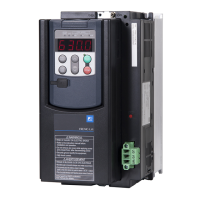2-11
Table 2.5 Names, Symbols and Functions of the Control Circuit Terminals (continued)
Classifi-
cation
Name Symbol Functions
Relay
output
General-purpose relay
outputs
[Y3A/C]
[Y4A/C]
[Y5A/C]
(1) Any one of output signals that can be assigned to terminals [Y1]
and [Y2] can also be assigned to this relay contacts, as a
general-purpose relay output, in order to use it for outputting a
signal.
(2) Whether excitation or non-excitation causes this terminal to
output a signal can be switched.
(3) Contact capacity and the life are shown by table below.
Contact capacity
Alarm relay output
(for any error)
[30A/B/C]
(1) When the protective function is activated, this terminal outputs
a contact signal (1C) to stop the motor.
(2) Any one of output signals that can be assigned to terminals [Y1]
and [Y2] can also be assigned to this relay contact as a
general-purpose relay output, in order to use it for outputting a
signal.
(3) Whether excitation or non-excitation causes this terminal to
output a signal can be switched.
(4) Contact capacity and the life are shown by table below.
Com-
munica-
tion
RS-485 communications
port 2
(On the terminal block)
[DX+]/
[DX-]
These I/O terminals are used as a communications port that
transmits data through the RS-485 multipoint protocol between the
inverter and a computer or other equipment such as a PLC or
elevator controller.
RS-485 communications
port 1 (For connection of the
RJ-45
Used to connect the keypad to the inverter. The inverter supplies
the power to the keypad via the extension cable for remote
[CAN-]
[CANG]
These I/O terminals are used as a communications port that
transmits data through the CANopen multipoint protocol between
the inverter and a computer or other equipment such as a PLC or
elevator controller.

